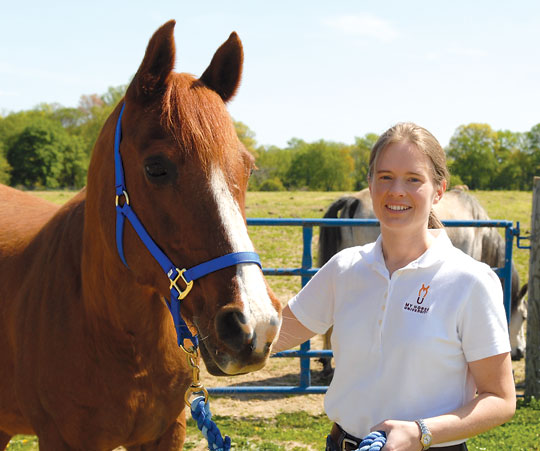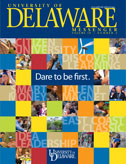Equine program off and running as herd, courses expand

ON THE GREEN | Since joining the College of Agriculture and Natural Resources in July 2009, Carissa Wickens hasn’t let the grass grow under her feet.
In her dual appointment as Cooperative Extension equine specialist and assistant professor of animal science, Wickens has been expanding the UD herd, developing new undergraduate courses, implementing adult and youth education programs and meeting with members of Delaware’s equine industry.
About the only thing she hasn’t done is to ride horses as much as she would have liked. “I keep a riding helmet in my office closet, but there hasn’t been enough time during the week to get on a horse,” says Wickens, who began riding at age 8. “There’s just too much going on.”
Not that she’s complaining. In fact, she says, her job is a perfect fit for her interests and strengths.
“I was excited to join UD because of the ability to become involved in hands-on teaching opportunities, not only with undergrads but also with youth and adults through my Extension appointment,” Wickens says. “I know what a valuable resource Extension can be for horse owners, and I want to assist Delawareans with their equine concerns.”
She has embraced her outreach role from her first few weeks on the job, which coincided with the state 4-H Horse Show at the Delaware State Fair. Accompanied by Susan Truehart Garey, Cooperative Extension’s livestock agent, Wickens strolled the fair’s stalls, show rings and exercise tracks, eager to connect with horse owners and enthusiasts. She’s also worked with the state Department of Agriculture to develop an equine educational needs assessment survey.
“I want to see what types of programs and educational resources our constituents are most interested in and learn more about the specific issues and topics they need help with,” she says. “The equine industry is very important to the state, and I want to offer all possible support.”
Delaware’s equine industry, which includes race tracks, equine show and competition facilities, and breeding, training and boarding operations, is strong and continues to grow, Wickens says. The state saw more than $279 million in expenditures for equine-related purposes in 2003, the most recent data available. There are about 13,000 horses in the state—most used by recreational riders and 41 percent in racing.
In addition to public outreach activities, Wickens has been just as busy in her role as assistant professor of animal science. She led in the purchase of four new horses—a quarter horse and three Arabians—to complement the three quarter horses and three Haflingers already part of UD’s herd. She also has assisted with recent improvements to the equine teaching facilities on campus.
This fall, she’ll be teaching “Equine Management,” a capstone course she’s developed.
Even though she isn’t riding as much as she would like, Wickens is at UD’s equine barn almost every day, whether to check in with a farrier who’s trimming a horse or connect with farm superintendent Scott Hopkins.
“I was impressed with Carissa at our initial meeting and even more so now that I have seen her at work,” says Jan Seitz, associate dean of the College of Agriculture and Natural Resources and director of UD Cooperative Extension. “I felt sure she would hit the ground running, but I had no idea how fast she would run.”
Article by Margo McDonough, AS ’86, ’95M





